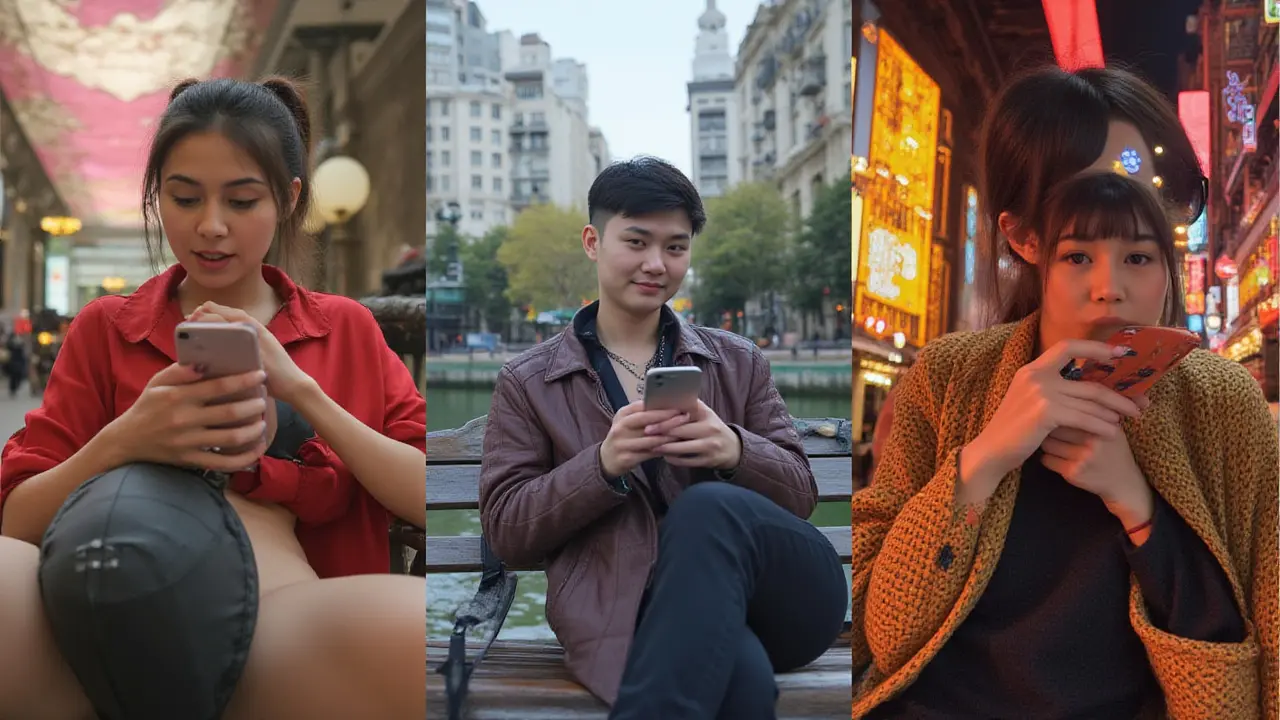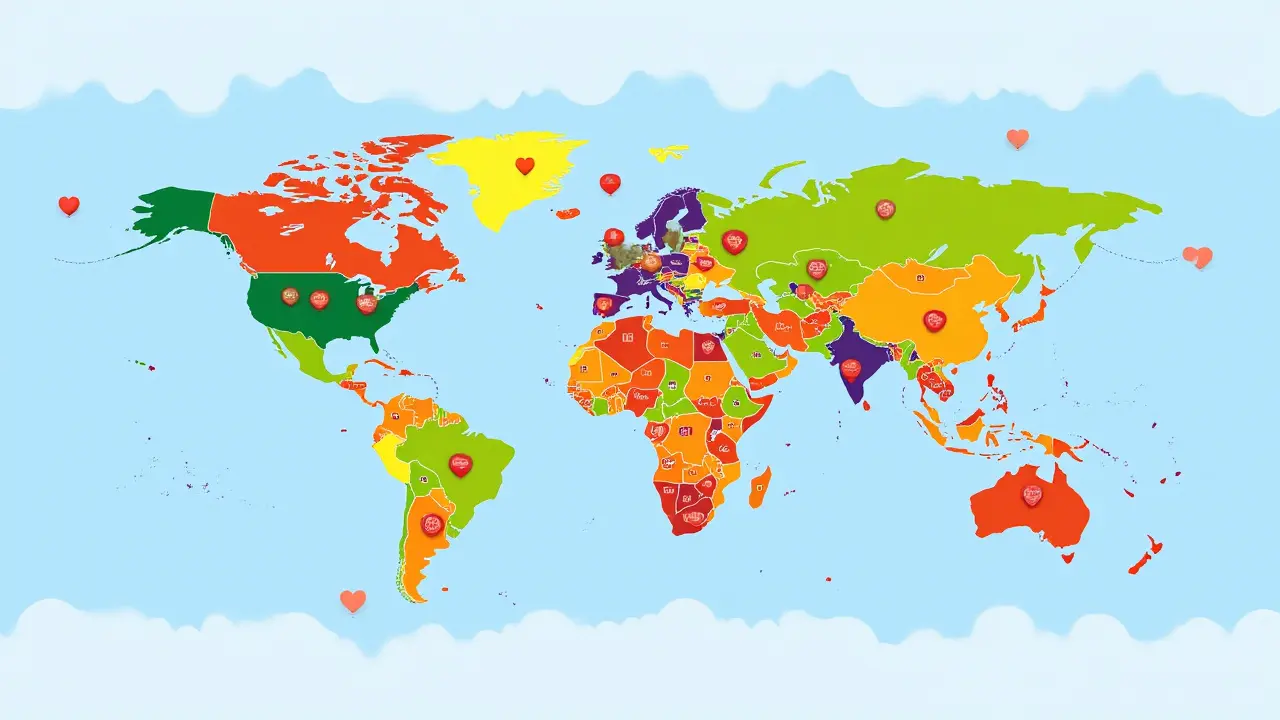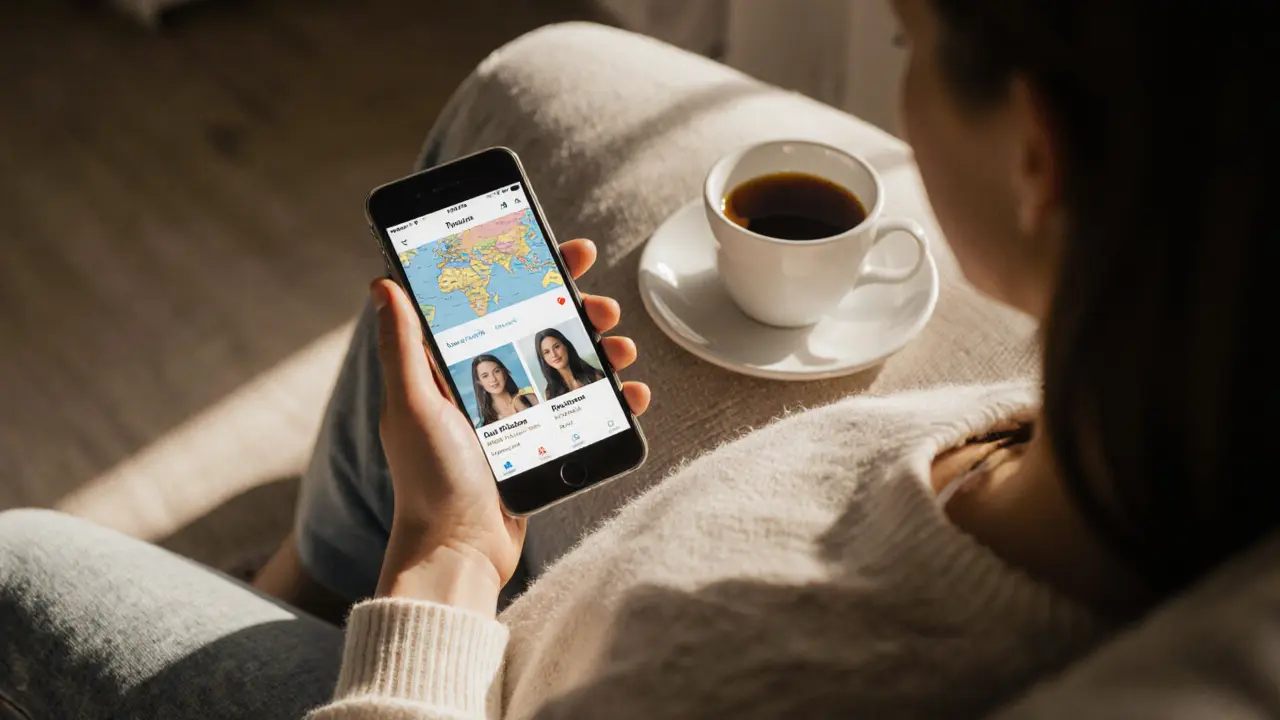Direct Answer – Which Country Uses Online Dating the Most?
If you asked a room full of people, “Where do the most online daters live?” the answer might not surprise you: it’s the United States. With an estimated 53 million people jumping into the online dating pool as of 2024, the US leads the world in both total numbers and market size. But that’s not the whole picture. When you look at percentages of the population, countries like Sweden, the UK, and even Brazil show impressive participation. Still, by the sheer volume of dating app users, the US confidently sits at the top.
Other nations aren’t far behind. The UK, India, China, and Brazil rack up millions of users. India in particular saw a jaw-dropping rise, doubling its active users between 2020 and 2024 as more people in urban centers grab smartphones. For anyone curious: Tinder holds the global crown as the most downloaded dating app, but regional favorites like Badoo and Tantan command massive audiences, too.
Key Points – Online Dating by the Numbers
- The United States has the highest number of online dating users globally (over 53 million).
- App downloads soared post-pandemic, triggering a 30% increase in online dating activity worldwide in 2021-2023.
- Countries like the UK, Germany, Brazil, India, and China each have millions of users and distinct app preferences.
- Tinder is the leading app by monthly active users, but apps like Badoo (Europe/Latin America) and Tantan (China) dominate locally.
- More than 320 million people worldwide use dating apps, with projections suggesting 450 million users by 2027.
With this in mind, knowing how your country stacks up—and what to expect—can help you date smarter, whether you’re swiping in New York, Berlin, or São Paulo.
Comprehensive Guide to Online Dating Around the World
Here’s something wild: if you open a dating app in any major global city, you’ll find singles from every walk of life. But why do some countries go all-in on online dating while others stick to traditional introductions? A big chunk of the answer is culture—a mix of urbanization, tech adoption, social attitudes, and even local regulations shapes who finds love through their phone. Take the US, for example. Fast-paced lifestyles, a focus on independence, and longer working hours encourage digital-first connections. People move states, chase new jobs, and don’t rely as much on family or social circles to meet potential partners. Online dating fills that gap.
Now, swing over to Sweden. Nearly half the adult population has tried online dating. Why? Tech-forward living, a high proportion of young singles, and open attitudes toward digital communication make Sweden a hotspot for love by algorithm. Compare it to India, where only urban millennials and Gen Z embrace dating apps, often mixing English with local languages. Local traditions still play a huge role, and some families steer clear of the idea. Yet, cities like Mumbai or Bangalore light up with activity on Tinder or Aisle every night.
You’ll see distinct regional flavors everywhere. Badoo rules in Spain, Russia, and much of Eastern Europe; Mamba is huge in Russia; South Korea favors apps like Amanda and Noondate built for its audience. Meanwhile, you’ll find serious matchmaking on eHarmony in the US and UK, while Brazil’s crowd loves chatting on Tinder and Par Perfeito alike. China presents a unique world with Tantan and Momo, boasting hundreds of millions of users looking for anything from casual chats to long-term relationships.
Why does all this matter? If you ever use a dating app abroad or match with someone from another country, understanding these cultural signals helps you read the room. For example, what’s considered direct or “normal” in the Netherlands might feel way too blunt in Japan. People in Germany may add plenty of personal details to their profiles, while Brits go for dry humor and quirky bios. Learning this stuff is half the fun—it makes you a better digital dater wherever you match.

Definition and Context – What is Online Dating, and Why Is It So Big?
At its heart, online dating is just another way for people to meet. Swap the smoky bar or awkward friend introduction for an app, a swipe, and maybe a quick chat. Tinder, Bumble, Hinge, Badoo, Tantan, OkCupid—the names may change, but profiles and photo galleries are universal. Modern dating apps use location data, machine learning, and even AI to suggest matches, turning your phone into a matchmaking powerhouse.
So, what’s the appeal? For starters, convenience. If you’re busy or shy, chatting online first takes the edge off. The chance to pick who you talk to, set your own pace, and (for some apps) filter by interests or even political opinions? That’s a game-changer if you live in a massive city or just want more control. Age, too, plays a role: Gen Z and Millennials grew up online, so swiping right feels more natural than starting small talk in a café. Even Baby Boomers are joining, especially on sites that focus on serious dating or second-chance romance after divorce or loss.
Here’s something a lot of people miss: countries at the top of the online dating charts don’t all use apps the same way. US singles are far more open to casual dating and short-term flings. In Germany, many treat app-dating almost like a job interview, carefully researching each profile. Countries like Japan and South Korea often expect more chatting before meeting, and privacy concerns lead to different app features—like photo blurring or voice-based introductions instead of text. As dating services compete, they’re adding video calls, live streaming, and advanced matching, which helps users stand out in crowded markets.
Benefits of Using Online Dating Globally
Let’s get real—online dating has changed the game for anyone who isn’t thrilled with the old “meet cute” at the grocery store. The biggest upside? Access. You aren’t limited to your neighborhood or workplace; your next date could live two blocks away, or on another continent. Need stats? According to Pew Research, over 60% of online daters in the US say they’ve had a mostly positive experience, and about 1 in 3 new marriages began with a swipe.
For LGBTQ+ singles, online dating is often safer, especially in conservative countries where meeting in person could be risky. That’s one reason apps like Grindr have an outsized role globally. Niche apps have blown up too, from JSwipe for Jewish singles to Muzmatch for Muslims, showing there’s space for everyone in the digital love market.
If you’re traveling, online dating is a great way to meet people and see the city from a local’s perspective. Just be upfront about your plans—nobody likes surprises if you’re only in town for a week. Even introverts score big from online dating; messaging before meeting helps break the ice. Plus, you get a sneak peek at interests and backgrounds, so it’s easier to spot people you actually click with.
Worried about safety? Trusted apps now have tighter security, video call vetting, and easy report/block features. Still, as in all walks of life, common sense rules when meeting strangers for the first time. Stick to public places, keep your friends in the loop, and don’t share financial details.
Popular Types of Online Dating and Trends by Country
Here’s where the numbers get interesting. Let’s break down who uses what, and how trends shift from country to country:
- United States: Tinder and Bumble are the go-to apps. Match.com and OkCupid attract people looking for long-term relationships. Hinge is big in urban areas and among professionals.
- United Kingdom: Tinder, Bumble, and Hinge are top picks, with Match.com and eHarmony also popular for the relationship-minded. Plenty of UK users joke about “posh” vs. “cheeky” app bios depending on the city!
- Brazil: Tinder dominates, but Badoo and Par Perfeito (a home-grown favorite) have millions of users. Chat-first culture means you’ll spend more time typing than swiping.
- India: Tinder leads, but Aisle and TrulyMadly carved out space for marriage-focused daters. Privacy features and parental consent options matter more than you’d expect.
- China: Tantan and Momo are the heavyweights, both catering to massive user bases. Unique features like gamified matching and group chats set these apart from their Western counterparts.
- Northern Europe (Sweden, Norway, Denmark): Badoo, Tinder, and local apps like Happy Pancake rock the charts. Profiles are usually open, direct, and full of thoughtful details.
To put data in perspective, here’s a quick look at the top 5 countries by total dating app users and market penetration (2024):
| Country | Estimated Users (Millions) | App Market Penetration (%) | Popular Apps |
|---|---|---|---|
| United States | 53 | 16 | Tinder, Bumble, Hinge, OkCupid |
| India | 43 | 3 | Tinder, Aisle, TrulyMadly |
| China | 41 | 3 | Tantan, Momo |
| Brazil | 24 | 9 | Tinder, Badoo, Par Perfeito |
| UK | 19 | 11 | Tinder, Bumble, Hinge, Match |
The variety goes beyond apps. Some countries still value web-based matchmaking, especially for older generations. In Japan, marriage agencies work hand-in-hand with dating apps for singles looking to settle down. South Korea’s unique “blind date” platforms use group video chats instead of classic profiles. And then, there are speed dating, video-first apps, and even friend-of-friend networks combining social and romantic discovery.
If you’re swiping in Europe, don’t be surprised to see people looking for travel partners or language exchange buddies—dating isn’t always the only goal. The variety is half the fun, so don’t be afraid to try local favorites when going abroad. It might mean the difference between striking up a chat and facing an empty inbox.





